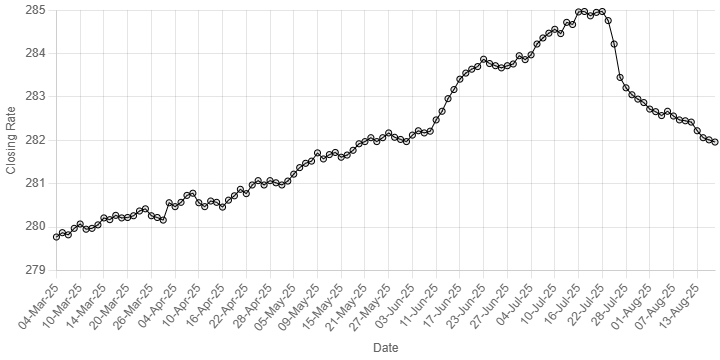The Australian Dollar (AUD) regained some balance on Wednesday, helping AUD/USD bounce back from Tuesday’s dip to around 0.6440 and climb above the key 0.6500 level.
This rebound came as the US Dollar (USD) softened, while traders kept an eye on US–China trade tensions and growing chatter about potential rate cuts from the Federal Reserve (Fed), possibly in October and again in December.
Local data still showing some fight
Despite a generally risk-off mood across markets, Australia’s economic data hasn’t completely rolled over. The final September manufacturing and services PMIs both eased a touch but stayed above the 50 mark, still pointing to expansion.
Retail Sales were up 1.2% in June, the August trade surplus only narrowed modestly to A$1.825 billion, and business investment continued to grow through Q2. GDP rose 0.6% in the April–June period and 1.8% over the last twelve months, hardly booming, but steady enough to keep confidence afloat.
The labour market, however, is showing the first signs of fatigue. Unemployment held at 4.2% in August, but total employment slipped by 5.4K. It’s not alarming yet, but it does suggest momentum is cooling slightly. With that in mind, all eyes will be on Thursday’s labour market report for September.
RBA keeps a watchful eye on prices
Inflation remains the Reserve Bank of Australia’s (RBA) main concern. The August Monthly CPI Indicator (Weighted Mean) ticked up to 3.0% from 2.8%, while Q2 CPI rose 0.7% quarter on quarter and 2.1% year on year. The Melbourne Institute’s October Consumer Inflation Expectations also inched higher to 4.8%.
That was enough to keep the RBA cautious at its 30 September meeting. The cash rate stayed at 3.60%, as widely expected, but the bank pulled back from earlier hints of possible easing. Policymakers noted that disinflation might be slowing after the CPI surprise, with Q3 inflation likely to come in hotter than the previous 2.6% forecast.
Governor Michele Bullock has kept her message consistent: every decision will be driven by the data, one meeting at a time. Rate cuts aren’t off the table, but the RBA wants to see clearer signs that supply–demand imbalances are easing.
For now, the trimmed mean CPI at 2.7% year on year in Q2 sits comfortably within the RBA’s 2–3% target range.
So far, markets are pricing in roughly 15 basis points of easing by year-end and about 35 basis points by end of 2026.
China still setting the tone
Australia’s prospects remain closely tied to China’s patchy recovery. Chinese GDP grew at an annualised 5.2% in Q2, but August retail sales missed expectations at 3.4%. September’s PMIs were mixed: manufacturing stayed in contraction at 49.8, while services just managed to hold steady at 50.0.
China’s trade surplus also narrowed to $90.45 billion in September (from $103.33 billion), and inflation stayed in the deflationary territory after the CPI fell to 0.3% in the year to September.

Meanwhile, the People’s Bank of China (PBoC) left its Loan Prime Rates (LPR) unchanged in September: the one-year at 3.00% and the five-year at 3.50%, in line with expectations.
Market flows still light
Speculative activity in the Aussie remains thin. With the Commodity Futures Trading Commission (CFTC) data delayed due to the US government shutdown, the most recent figures available as of 23 September still showed non-commercial traders leaning net short, suggesting most of the bearish sentiment is already in the price.
Technical landscape
AUD/USD faces a strong contention zone around its critical 200-day SMA near 0.6420.
Indeed, in case sellers push harder and the pair breaks below the latter, the August base at 0.6414 (August 21) should emerge as the next support followed by the June floor at 0.6372 (June 23).
Alternatively, there is interim resistance at the 100-day and 55-day SMAs at 0.6532 and 0.6544, respectively, prior to the October top at 0.6629 (October 1), before the 2025 ceiling at 0.6707 (September 17). Extra gains should look at the 2024 peak at 0.6942 (September 30), just ahead of the 0.7000 yardstick.
Momentum indicators remain on the bearish side: the Relative Strength Index (RSI) bounces past 43, indicative that sellers remain in control, while the Average Directional Index (ADX) near 17 suggests that the ongoing trend seems to be gathering strength.
AUD/USD daily chart

Waiting for a catalyst
Overall, AUD/USD is still stuck in a wide 0.6400–0.6700 band, waiting for a clear catalyst to break free. A stronger run of Chinese data, a more dovish tilt from the Fed, or a gentler message from the RBA could be the trigger that finally gives the pair direction.
RBA FAQs
The Reserve Bank of Australia (RBA) sets interest rates and manages monetary policy for Australia. Decisions are made by a board of governors at 11 meetings a year and ad hoc emergency meetings as required. The RBA’s primary mandate is to maintain price stability, which means an inflation rate of 2-3%, but also “..to contribute to the stability of the currency, full employment, and the economic prosperity and welfare of the Australian people.” Its main tool for achieving this is by raising or lowering interest rates. Relatively high interest rates will strengthen the Australian Dollar (AUD) and vice versa. Other RBA tools include quantitative easing and tightening.
While inflation had always traditionally been thought of as a negative factor for currencies since it lowers the value of money in general, the opposite has actually been the case in modern times with the relaxation of cross-border capital controls. Moderately higher inflation now tends to lead central banks to put up their interest rates, which in turn has the effect of attracting more capital inflows from global investors seeking a lucrative place to keep their money. This increases demand for the local currency, which in the case of Australia is the Aussie Dollar.
Macroeconomic data gauges the health of an economy and can have an impact on the value of its currency. Investors prefer to invest their capital in economies that are safe and growing rather than precarious and shrinking. Greater capital inflows increase the aggregate demand and value of the domestic currency. Classic indicators, such as GDP, Manufacturing and Services PMIs, employment, and consumer sentiment surveys can influence AUD. A strong economy may encourage the Reserve Bank of Australia to put up interest rates, also supporting AUD.
Quantitative Easing (QE) is a tool used in extreme situations when lowering interest rates is not enough to restore the flow of credit in the economy. QE is the process by which the Reserve Bank of Australia (RBA) prints Australian Dollars (AUD) for the purpose of buying assets – usually government or corporate bonds – from financial institutions, thereby providing them with much-needed liquidity. QE usually results in a weaker AUD.
Quantitative tightening (QT) is the reverse of QE. It is undertaken after QE when an economic recovery is underway and inflation starts rising. Whilst in QE the Reserve Bank of Australia (RBA) purchases government and corporate bonds from financial institutions to provide them with liquidity, in QT the RBA stops buying more assets, and stops reinvesting the principal maturing on the bonds it already holds. It would be positive (or bullish) for the Australian Dollar.







